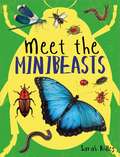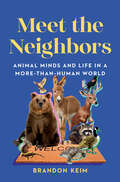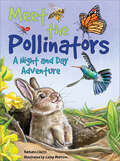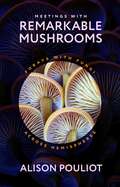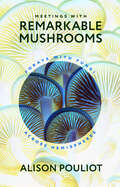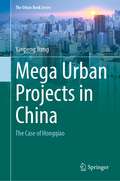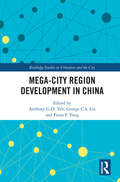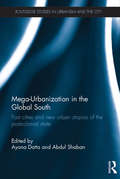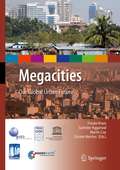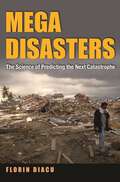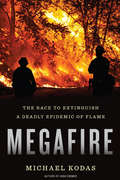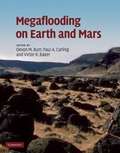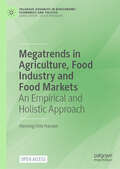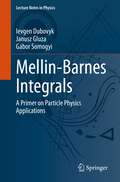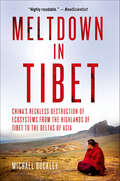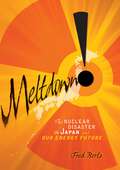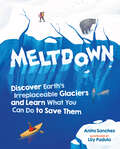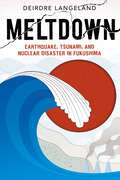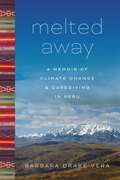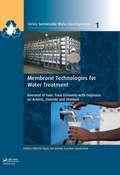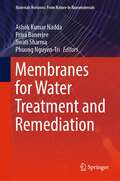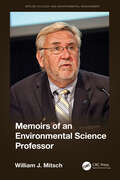- Table View
- List View
Meet the Minibeasts
by Sarah RidleyBecome a minibeast expert with this easy-to-understand guide to the wonderful and important creatures that live beside us. Have you ever wondered what the difference between a moth and a butterfly is? Or have you ever thought about how bees live together? This fascinating and comprehensive book for children aged 6+ is full of interesting facts and brilliant photographs. It also features guides to spotting your favourite minibeast in their natural habitats.Minibeasts covered: ants, aphids, bees, beetles, bugs, butterflies, centipedes, cicadas, crickets, damselflies, dragonflies, earwigs, flies, grasshoppers, harvestmen, millipedes, mites, moths, pond skaters, slugs, snails, spiders, termites, ticks, wasps, woodlice, worms.
Meet the Neighbors: Animal Minds and Life in a More-than-Human World
by Brandon KeimWhat does the science of animal intelligence mean for how we understand and live with the wild creatures around us? Honeybees deliberate democratically. Rats reflect on the past. Snakes have friends. In recent decades, our understanding of animal cognition has exploded, making it indisputably clear that the cities and landscapes around us are filled with thinking, feeling individuals besides ourselves. But the way we relate to wild animals has yet to catch up. In Meet the Neighbors, acclaimed science journalist Brandon Keim asks: what would it mean to take the minds of other animals seriously? In this wide-ranging, wonder-filled exploration of animals’ inner lives, Keim takes us into courtrooms and wildlife hospitals, under backyard decks and into deserts, to meet anew the wild creatures who populate our communities and the philosophers, rogue pest controllers, ecologists, wildlife doctors, and others who are reimagining our relationships to them. If bats trade favors and groups of swans vote to take off by honking, should we then see them as fellow persons—even members of society? When we come to understand the depths of their pleasures and pains, the richness of their family lives and their histories, what do we owe so-called pests and predators, or animals who are sick or injured? Can thinking of nonhumans as our neighbors help chart a course to a kinder, gentler planet? As Keim suggests, the answers to these questions are central to how we understand not only the rest of the living world, but ourselves. A beguiling invitation to discover an expanded sense of community and kinship beyond our own species, Meet the Neighbors opens our eyes to the world of vibrant intelligence just outside our doors.
Meet the Pollinators: A Night and Day Adventure
by Barbara CilettiThis vital and simply told story of pollination offers lush visual effects that illuminate their ongoing work by day and by night. Presented narratively, this title captivates young learners, emphasizing pollinators' vital role in our planet's survival. It conveys that even small creatures wield significant influence, illustrating pollinators' continuous journey for food. The intricate dance between pollinators and flowers is nature's wisdom in action. As flowers beckon, pollinators respond, playing a pivotal role in life's cycle. This dynamic exchange narrates the story of pollination, where pollinators fertilize plants while obtaining sustenance. Key Features: Engages young learners, emphasizing pollinators' life-giving role. Conveys that even small creatures make enormous Earth contributions. Educates about 24/7 global pollination value. Makes pollination understanding visual and accessible. Provides a closer look at pollination as a story. Includes additional teaching materials that enrich learning with pollinator bios, flower diagrams, and pollinator garden flower suggestions. This story underscores the importance of caring for Earth, highlighting its reciprocal response to positive stewardship.
Meetings with Remarkable Mushrooms: Forays with Fungi across Hemispheres
by Alison PouliotA whirlwind journey through fungus frontiers that underscores how appreciating fungi is key to understanding our planet’s power and fragility. What can we learn from the lives of fungi? Splitting time between the northern and southern hemispheres, ecologist Alison Pouliot ensures that she experiences two autumns per year in the pursuit of fungi—from Australia’s deserts to Iceland’s glaciers to America’s Cascade Mountains. In Meetings with Remarkable Mushrooms, we journey alongside Pouliot, magnifiers in hand, as she travels the world. With Pouliot as our guide, we smell fire-loving truffles that transform their scent after burning to lure mammals who eat them and, ultimately, spread their spores. We spot the eerie glow of the ghost fungus, a deceptive entity that looks like an edible oyster mushroom but will soon heave back out—along with everything else in your stomach—if you take a bite. And we crawl alongside vegetable caterpillars, which are neither vegetable nor caterpillar but a fungus that devours insects from the inside out. Featuring stunning color photographs of these mycological miracles, Meetings with Remarkable Mushrooms shows that understanding fungi is fundamental for harmonizing with the natural world.
Meetings with Remarkable Mushrooms: Forays with Fungi across Hemispheres
by Alison PouliotA whirlwind journey through fungus frontiers that underscores how appreciating fungi is key to understanding our planet’s power and fragility.What can we learn from the lives of fungi? Splitting time between the northern and southern hemispheres, ecologist Alison Pouliot ensures that she experiences two autumns per year in the pursuit of fungi—from Australia’s deserts to Iceland’s glaciers to America’s Cascade Mountains. In Meetings with Remarkable Mushrooms, we journey alongside Pouliot, magnifiers in hand, as she travels the world.With Pouliot as our guide, we smell fire-loving truffles that transform their scent after burning to lure mammals who eat them and, ultimately, spread their spores. We spot the eerie glow of the ghost fungus, a deceptive entity that looks like an edible oyster mushroom but will soon heave back out—along with everything else in your stomach—if you take a bite. And we crawl alongside vegetable caterpillars, which are neither vegetable nor caterpillar but a fungus that devours insects from the inside out.Featuring stunning color photographs of these mycological miracles, Meetings with Remarkable Mushrooms shows that understanding fungi is fundamental for harmonizing with the natural world.
Mega Urban Projects in China: The Case of Hongqiao (The Urban Book Series)
by Yanpeng JiangThis book is the first systematic account of mega urban projects in China, covering their construction, operation and planning. It is a detailed examination of the planning and construction of Hongqiao and its impact on local residents. In short, the aim of this book is to examine the process of planning and development of the Hongqiao transportation and commercial zone, to explore its relationship to urban development and spatial restructuring in Shanghai, and in doing so to comment on and critique the nature of urban change in contemporary China, which is characterized as property- and infrastructure-driven. Mega urban projects are arguably the quintessential symbol of entrepreneurial urbanism, and it is no coincidence that they have become a familiar part of the urban scene throughout the world, not least in East Asia. They can be seen as both a consequence of, and a response to, the deindustrialization of leading cities, first in North America and Europe and then in East Asia, as economies transitioned to globalized neoliberalism. This book provides a comprehensive overview of the main features of the land-based urban growth coalition formed in Hongqiao by introducing the detailed picture of the Hongqiao project, and it outlines the recent example of the competitive rush to urban projects in China's largest cities that has led to the proliferation of new financial districts in Beijing and Guangzhou.
Mega-City Region Development in China (Routledge Studies in Urbanism and the City)
by Fiona F. Yang Anthony G. O. Yeh George C. S. LinThis book sheds light on the mega-city region development in China as a new form of urbanization which plays a crucial role in the economic development of the country. It examines the challenges faced by the mega-city regions and opens up avenues for debates and further research. Economic reform of 1978 has led to an unprecedented growth in the population and economic development of China. A large portion of this increased urban population and the corresponding economic growth has been concentrated in the mega-city regions, such as Beijing-Tianjin-Hebei (BTH), Yangtze River Delta (YRD) and Pearl River Delta (PRD). These three mega-city regions have less land but more people and thus higher economy, resulting in various issues and challenges faced by these regions. These challenges pertain to the socio-economic development, transport, environment, governance and development strategy, which this book explores through case studies of Guangdong-Hong Kong-Macao Greater Bay Area, Beijing-Tianjin-Hebei and Wuhan. This book also explains and analyses the economy, migration processes, transport development, environmental conditions and governance of the mega-city regions of China. With an overview of China’s rapid urbanisation and the consequent economic growth, this book provides an essential understanding of related issues in order to establish appropriate strategies and policies to sustain the process of mega-city region development.
Mega-Urbanization in the Global South: Fast cities and new urban utopias of the postcolonial state (Routledge Studies in Urbanism and the City)
by Abdul Shaban Ayona DattaThe global south is entering an ‘Urban Age’ where, for the first time in history, more people will be living in cities than in the countryside. The logics of this prediction have a dominant framing - rapid urbanization, uncontrolled migration, resource depletion, severe fuel shortages and the breakdown of law and order. We are told that we must be prepared. The solution is simple, they say. Mega-urbanization is an opportunity for economic growth and prosperity. Therefore we must build big, build new and build fast. With contributions from an international range of established and emerging scholars drawing upon real-world examples, Mega-Urbanization in the Global South is the first to use the lens of speed to examine the postcolonial ‘urban revolution’. From the mega-urbanization of Lusaka, to the production of satellite cities in Jakarta, to new cities built from scratch in Masdar, Songdo and Rajarhat, this book argues that speed is now the persistent feature of a range of utopian visions that seek to expedite the production of new cities. These ‘fast cities’ are the enduring images of postcolonial urbanism, which bypass actually existing urbanisms through new power-knowledge coalitions of producing, knowing and governing the city. The book explores three main themes. Part I examines fast cities as new urban utopias which propagate the illusion that they are ‘quick fix’ sustainable solutions to insulate us from future crises. Part II discusses the role of the entrepreneurial state that despite its neoliberalisation is playing a key role in shaping mega-urbanization through laws, policies and brute force. Part III finally delves into how fast cities built by entrepreneurial states actually materialise at the scale of regional urbanization rather than as metropolitan growth. This book explores the contradictions between intended and unintended outcomes of fast cities and points to their fault lines between state sovereignty, capital accumulation and citizenship. It concludes with a vision and manifesto for ‘slow’ and decelerated urbanism. This timely and original book presents urban scholars with the theoretical, empirical and methodological challenges of mega-urbanization in the global south, as well as highlighting new theoretical agendas and empirical analyses that these new forms of city-making bring to the fore.
Megacities: Our Global Urban Future
by Frauke Kraas Martin Coy Surinder Aggarwal Günter MertinsAs urbanization continues, and even accelerates, scientists estimate that by 2015 the world will have up to 60 'megacities' - urban areas with more than five million inhabitants. With the irresistible economic attractions of urban centers, particularly in developing countries, making the influx of citizens unstoppable, many of humankind's coming social, economic and political dramas will be played out in megacities. This book shows how geographers and Earth scientists are contributing to a better understanding of megacities. The contributors analyze the impact of socio-economic and political activities on environmental change and vice versa, and identify solutions to the worst problems. They propose ways of improving the management of megacities and achieving a greater degree of sustainability in their development. The goals, of wise use of human and natural resources, risk reduction (both social and environmental) and quality of life enhancement, are agreed upon. But, as this text proves, the means of achieving these ends are varied. Hence, chapters cover an array of topics, from health management in Indian megacities, to planning in New York, to transport solutions for the chronically traffic-choked Bangkok. Authors cover the impact of climate change on megacities, as well as less tangible issues such as socio-political fragmentation in the urban areas of Rio de Janeiro. This exploration of some of the most crucial issues that we face as a species sets out research that is of the utmost importance, with the potential to contribute substantially to global justice and peace - and thereby prosperity.
Megadisasters: The Science of Predicting the Next Catastrophe
by Florin DiacuThe history and science behind efforts to predict major disasters, from tsunamis to stock market crashesCan we predict cataclysmic disasters such as earthquakes, volcanic eruptions, or stock market crashes? The Indian Ocean tsunami of 2004 claimed more than 200,000 lives. Hurricane Katrina killed over 1,800 people and devastated the city of New Orleans. The recent global financial crisis has cost corporations and ordinary people around the world billions of dollars. Megadisasters is a book that asks why catastrophes such as these catch us by surprise, and reveals the history and groundbreaking science behind efforts to forecast major disasters and minimize their destruction.Each chapter of this exciting and eye-opening book explores a particular type of cataclysmic event and the research surrounding it, including earthquakes, tsunamis, volcanic eruptions, hurricanes, rapid climate change, collisions with asteroids or comets, pandemics, and financial crashes. Florin Diacu tells the harrowing true stories of people impacted by these terrible events, and of the scientists racing against time to predict when the next big disaster will strike. He describes the mathematical models that are so critical to understanding the laws of nature and foretelling potentially lethal phenomena, the history of modeling and its prospects for success in the future, and the enormous challenges to scientific prediction posed by the chaos phenomenon, which is the high instability that underlies many processes around us.Yielding new insights into the perils that can touch every one of us, Megadisasters shows how the science of predicting disasters holds the promise of a safer and brighter tomorrow.
Megafire: The Race to Extinguish a Deadly Epidemic of Flame
by Michael KodasThis bestselling author of High Crimes explores what causes forest fires and captures their danger and the heroism of those who fight them.In Megafire, a world-renowned journalist and forest fire expert travels to dangerous and remote wildernesses, as well as to the backyards of people faced with these catastrophes, to look at the heart of this phenomenon and witness firsthand the heroic efforts of the firefighters and scientists racing against time to stop it—or at least to tame these deadly flames. From Colorado to California, China to Canada, head to the frontlines on the ground and in the air, as well as in the laboratories, universities, and federal agencies where this battle rages on. Through this prism of perspectives, Kodas zeroes in on some of the most terrifying environmental disasters in recent years—the Yarnell Hill Fire in Arizona that took the lives of nineteen elite &“hotshot&” firefighters, the Waldo Canyon Fire that overwhelmed the city of Colorado Springs—and more in a page-turning narrative that puts a face on the brave people at the heart of this issue. Megafiredescribes the profound global impact of these fires and will change the way we think about the environment and the precariousness of our world. &“I don't know any writer better equipped to explain what's gone wrong than Michael Kodas, who shines a light both on the astonishing bravery of the hotshots on the front lines and on the waste and ineptitude of the politicians and bureaucrats who too often fail them, sometimes with fatal consequences.&”—Dan Fagin, author of the Pulitzer Prize-winning Toms River: A Story of Science and Salvation
Megaflooding on Earth and Mars
by Devon M. Burr Paul A. Carling Victor R. BakerMegaflooding is the sudden discharge of exceptional volumes of water. Megafloods have significantly altered the terrain of Earth and Mars, and may have acted as triggers for climate change on these planets. Recently, research into megaflooding has made important advances: on Earth, real-time measurements of contemporary floods in Iceland complement research into older and larger terrestrial floods, while on Mars terabytes of data from several spacecraft orbiting that planet are dramatically revising our view of flooding there. Beginning with a historical overview of flood science, the book presents sections on morphology and mechanisms, flood sedimentology, and modeling, each illustrated with examples from Earth and Mars. By juxtaposing terrestrial and Martian research, this volume creates a unique synthesis to further our understanding of these enormous paleoflood events. It is an invaluable reference for researchers and students of hydrology, geomorphology, sedimentology and planetary science, as well as environmental and hydraulic engineers.
Megatrends in Agriculture, Food Industry and Food Markets: An Empirical and Holistic Approach (Palgrave Advances in Bioeconomy: Economics and Policies)
by Henning Otte HansenThis book offers a research-based, holistic overview of the entire value chain of the global food industry. It captures and defines over 80 contemporary ‘megatrends’ in agriculture and the food market that can be empirically documented and have a major impact on business, economies, industries, societies, and individuals. Today the world is characterized by more uncertainty and unpredictability than in previous periods. In the midst of these changing times, the book demonstrates how a number of more stable trends still exist within global agriculture, which can be important indicators in both the short and long term. The book highlights how developments in agriculture, the food industry and food markets have a central position in policy debates around climate change, sustainability, food crises, hunger, and food supply, and shows how by identifying various megatrends and their underlying economic drivers, as well as potential disruptive forces, we can reduce both risk and vulnerability in the future. Megatrends within consumption, food loss, food crises, international trade, retail industry and ownership of farms are discussed and their relevance illuminated for a wide range of stakeholders, including policy-makers and agri-businesses, as well as farmers and consumers. This book will be a useful resource for researchers in agricultural and environmental economics, as well as policy-makers and professionals in agri-food organisations and public food institutions. This is an open access book.
Meiobenthos in the Sub-equatorial Pacific Abyss
by Teresa RadziejewskaAgainst the backdrop of the environmental setting of the subequatorial NE Pacific abyssal plain, the book will characterise the meiobenthos as an ecological category in the deep sea and introduce research lines meiobenthic studies are applied to, including environmental assessments of human-induced disturbance of the deep seafloor. It will proceed to present an overview of the current knowledge on the meiobenthos of the area of concern and will discuss general considerations regarding the use of meiobenthos as indicator of seafloor disturbance. It will address the question of deep-sea mineral resources development versus benthic communities and will present an overview of field studies ("experiments") aimed at assessing the magnitude of potential impact associated with seafloor resources development (polymetallic nodule mining in particular) in the Pacific.
Mellin-Barnes Integrals: A Primer on Particle Physics Applications (Lecture Notes in Physics #1008)
by Ievgen Dubovyk Janusz Gluza Gábor SomogyiIn this book, the authors discuss the Mellin-Barnes representation of complex multidimensional integrals. Experiments frontiered by the High-Luminosity Large Hadron Collider at CERN and future collider projects demand the development of computational methods to achieve the theoretical precision required by experimental setups. In this regard, performing higher-order calculations in perturbative quantum field theory is of paramount importance. The Mellin-Barnes integrals technique has been successfully applied to the analytic and numerical analysis of integrals connected with virtual and real higher-order perturbative corrections to particle scattering. Easy-to-follow examples with the supplemental online material introduce the reader to the construction and the analytic, approximate, and numeric solution of Mellin-Barnes integrals in Euclidean and Minkowskian kinematic regimes. It also includes an overview of the state-of-the-art software packages for manipulating and evaluating Mellin-Barnes integrals. The book is meant for advanced students and young researchers to master the theoretical background needed to perform perturbative quantum field theory calculations.
Meltdown in Tibet: China's Reckless Destruction of Ecosystems from the Highlands of Tibet to the Deltas of Asia
by Michael BuckleyTibetans have experienced waves of genocide since the 1950s. Now they are facing ecocide. The Himalayan snowcaps are in meltdown mode, due to climate change—accelerated by a rain of black soot from massive burning of coal and other fuels in both China and India. The mighty rivers of Tibet are being dammed by Chinese engineering consortiums to feed the mainland's thirst for power, and the land is being relentlessly mined in search of minerals to feed China's industrial complex. On the drawing board are plans for a massive engineering project to divert water from Eastern Tibet to water-starved Northern China. Ruthless Chinese repression leaves Tibetans powerless to stop the reckless destruction of their sacred land, but they are not the only victims of this campaign: the nations downstream from Tibet rely heavily on rivers sourced in Tibet for water supply, and for rich silt used in agriculture. This destruction of the region's environment has been happening with little scrutiny until now. In Meltdown in Tibet, Michael Buckley turns the spotlight on the darkest side of China's emergence as a global super power.
Meltdown!: The Nuclear Disaster in Japan and Our Energy Future (Single Titles Ser.)
by Fred BortzJapan. March 11, 2011. 2:46 P.M. The biggest earthquake in Japan's history—and one of the world's five most powerful since 1900—devastated the Tohoku region, 320 kilometers (200 miles) northeast of Tokyo. It triggered a huge tsunami that left crippling damage in its wake. More than 13,000 people drowned, and thousands of buildings and homes were reduced to rubble. As people assessed the damage, they made the most frightening discovery of all: the Fukushima #1 nuclear power plant was seriously damaged and three of its six reactors were heading for meltdowns. Workers tried desperately—but unsuccessfully—to save them. Explosions and fires released radioactivity into the air. Within days the Japanese government declared a 20-kilometer (12-mile) evacuation zone. The future of the plant, the long-term health of those exposed to radiation, and the effects on the environment remained uncertain. Learn more about this massive catastrophe as Dr. Fred Bortz examines both the human tragedy and the scientific implications of the nuclear meltdown. Compare this disaster to similar nuclear events in the United States and in Ukraine, and move ahead with Dr. Bortz as he explores the global debate about the future of nuclear power and alternative sources of energy.
Meltdown: Discover Earth's Irreplaceable Glaciers and Learn What You Can Do to Save Them
by Anita SanchezMeltdown: Discover Earth's Irreplaceable Glaciers and Learn What You Can Do to Save Them introduces kids to the &“what,&” the &“how,&” and the &“why&” of glaciers and climate change, exploring what will happen to our planet—and us—if the glaciers keep disappearing. Meltdown is a much-needed alarm bell, but it is also proactive, offering actionable steps for kids and their families to reduce their carbon footprints and save the environment.
Meltdown: Earthquake, Tsunami, and Nuclear Disaster in Fukushima
by Deirdre LangelandDeirdre Langeland's Meltdown explores for middle grade readers the harrowing story of the deadly earthquake, tsunami, and nuclear meltdown that caused the 2011 Fukushima power plant disasterOn March 11, 2011, the largest earthquake ever measured in Japan occurred off the northeast coast. It triggered a tsunami with a wall of water 128 feet high. The tsunami damaged the nuclear power plant in Fukushima triggering the nightmare scenario--a nuclear meltdown.For six days, employees at the plant worked to contain the meltdown and disaster workers scoured the surrounding flooded area for survivors.This book examines the science behind such a massive disaster and looks back at the people who experienced an unprecedented trifecta of destruction.
Melted Away: A Memoir of Climate Change and Caregiving in Peru
by Barbara Drake-VeraA prolific poet as a child, Barbara Drake-Vera loved writing almost as much as she adored her father, a moody postal employee with an elaborate comb-over and a fondness for Mahler. But when her successes sparked his rage, Barbara silenced her voice for years, terrified even to see her name in print. By age forty-nine, she was a professional journalist living in Peru and collaborating with her husband, a Peruvian-born photographer, to report on melting glaciers in the Andes, far from the reach of her father. Melted Away recounts what happens after her father is diagnosed with advancing Alzheimer’s and Barbara takes him into her home in Lima, beginning a process of self-discovery that uncovers a path toward personal and family healing. A diverse group of allies support her on this quest: a trio of caregiving women from the provinces, who serve as home-health aides; a mischievous, Cervantes-quoting, nonagenarian suitor; and a stubborn alpaca herder who lives beneath a long-worshipped, life-sustaining Andean glacier now melting from rapid climate change.Candid, poignant, and deeply researched, Melted Away is the true story of how a writer at midlife reclaims her agency, and an ardent plea to care for the planet by embracing collectivism and mutual aid.
Melting Away
by Camille SeamanFor ten years Camille Seaman has documented the rapidly changing landscapes of Earth's polar regions. As an expedition photographer aboard small ships in the Arctic and Antarctic, she has chronicled the accelerating effects of global warming on the jagged face of nearly fifty thousand icebergs. Seaman's unique perspective of the landscape is entwined with her Native American upbringing: she sees no two icebergs as alike; each responds to its environment uniquely, almost as if they were living beings. Through Seaman's lens, each towering chunk of ice--breathtakingly beautiful in layers of smoky gray and turquoise blue--takes on a distinct personality, giving her work the feel of majestic portraiture. Melting Away collects seventy-five of Seaman's most captivating photographs, lifeaffirming images that reveal not only what we have already lost, but more importantly what we still have that is worth fighting to save.
Membrane Biophysics
by Jack A. Tuszynski Mohammad AshrafuzzamanPhysics, mathematics and chemistry all play a vital role in understanding the true nature and functioning of biological membranes, key elements of living processes. Besides simple spectroscopic observations and electrical measurements of membranes we address in this book the phenomena of coexistence and independent existence of different membrane components using various theoretical approaches. This treatment will be helpful for readers who want to understand biological processes by applying both simple observations and fundamental scientific analysis. It provides a deep understanding of the causes and effects of processes inside membranes, and will thus eventually open new doors for high-level pharmaceutical approaches towards fighting membrane- and cell-related diseases.
Membrane Technologies for Water Treatment: Removal of Toxic Trace Elements with Emphasis on Arsenic, Fluoride and Uranium (Sustainable Water Developments - Resources, Management, Treatment, Efficiency and Reuse #1)
by Jan Hoinkis Alberto Figoli Jochen BundschuhFocuses on the application of membrane technologies in removing toxic metals\metalloids from water. Particular attention is devoted to the removal of arsenic, uranium, and fluoride. These compounds are all existing in the earth’s crust at levels between two and five thousands micrograms per kg (parts per million) on average and these compounds can be considered highly toxic to humans, who are exposed to them primarily from air, food and water. In order to comply with the new maximum contaminant level, numerous studies have been undertaken to improve established treatments or to develop novel treatment technologies for removing toxic metals from contaminated surface and groundwater. Among the technologies available, applicable for water treatment, membrane technology has been identified as a promising technology to remove such toxic metals from water. The book describes both pressure driven (traditional processes, such as Nanofiltration, Reverse Osmosis, Ultrafiltration,etc) and more advanced membrane processes (such as forward osmosis, membrane distillation, and membrane bio-reactors) employed in the application of interest. Key aspect of this book is to provide information on both the basics of membrane technologies and on the results depending on the type of technology employed.
Membranes for Water Treatment and Remediation (Materials Horizons: From Nature to Nanomaterials)
by Swati Sharma Ashok Kumar Nadda Priya Banerjee Phuong Nguyen-TriThis book provides comprehensive description of polymeric membranes in water treatment and remediation. It describes both the sustainability challenges and new opportunities to use membranes for water decontamination. It also discusses the environmental-related issues, challenges and advantages of using membrane-based systems and provides comprehensive description of various polymeric membranes, nanomaterials, biomolecules and their integrated systems for wastewater treatment. Various topics covered in this book are direct pressure-driven and osmotic-driven membrane processes, hybrid membrane processes (such as membrane bioreactors and integrating membrane separation with other processes), and resource recovery-oriented membrane-based processes. The book will be useful for students, researchers and professionals working in the area of materials science and environmental chemistry.
Memoirs of an Environmental Science Professor: A Memoir (Applied Ecology and Environmental Management)
by William MitschThis book shows, through real and current examples from the field of environmental and wetland science, that personal and professional success depends on persistence and a refusal to compromise on "doing the right thing" which for Professor Mitsch meant saving some of the world’s most important ecosystems, as well as educating future researchers and the general public along the way. Case studies described in this book illustrate that persistence pays off especially when the cause is motivated by something as important as improving our natural environment. They explain clearly that success is not easy, disasters and failures are part of the process, but having goals result in meaningful steps toward it. Features Emphasizes how it is possible to develop long-term goals and persistence for success both in the academic and environmental world. Offers examples set in universities across America and highlights important national wetlands such as the Florida Everglades, the Kankakee River Marshlands in the Great Lakes region, and Ohio’s Olentangy River Wetland Park, a Ramsar Wetland of International Importance. Speaks to scientists from across the country and the world. Discusses chronologically the developments and the achievements of environmental /wetland fields on a global scale. Explains how his personal achievements contributed to the growth of wetland and environmental sciences. Students and professionals in the physical and biological sciences, including chemistry, environmental science, ecological fields, and environmental policy, and especially environmental consultants such as scientists, managers, and engineers, will feel a sense of camaraderie with Professor Mitsch. His longstanding career and devotion to environmental and wetland sciences are an inspiration to all who currently work in the field, aspire to, or simply harbor a sense of appreciation about the natural world and want to learn more about steps that can be taken to manage and protect our planet and the environment.
